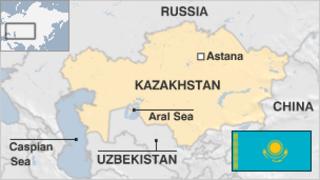Kazakhstan profile
A huge country the size of Western Europe, Kazakhstan has vast mineral resources and enormous economic potential.
The varied landscape stretches from the mountainous, heavily populated regions of the east to the sparsely populated, energy-rich lowlands in the west, and from the industrialised north, with its Siberian climate and terrain, through the arid, empty steppes of the centre, to the fertile south.
Ethnically the former Soviet republic is as diverse, with the Kazakhs making up nearly two thirds of the population, ethnic Russians just under a quarter, and smaller minorities the rest. Suppressed under Soviet rule, the main religion, Islam, is undergoing a revival.
Since independence following the collapse of the Soviet Union in 1991, major investment in the oil sector has brought rapid economic growth, and eased some of the stark disparities in wealth of the 1990s.
FACTS
Republic of Kazakhstan
Capital: Nur-Sultan
Population 18 million (UN, 2012)
Area 2.7 million sq km (1 million sq miles)
Major languages Kazakh, Russian
Major religions Islam, Christianity
Life expectancy 68 years (men), 77 years (women) (UN)
Currency Tenge
LEADERS
President: Kassym-Jomart Tokayev
A long-standing colleague of independent Kazakhstan’s founder, Nursultan Nazarbayev, Kassym-Jomart Tokayev took over as president when his mentor suddenly stepped down in March 2019.
Mr Tokayev was chairman of the Senate at the time, and says he will continue the policies of his predecessor and rely on his opinion in key policy matters.
He won a snap presidential election in June 2019 to consolidate his position.
The new president has served in various senior positions since independence in 1991, including prime minister and foreign minister.
Nursultan Nazarbayev’s long authoritarian rule faced few challenges from weak opposition parties, and he managed a gradual transfer of power that guarantees him a future role as chairman for life of a newly-strengthened Security Council.
In addition, his daughter Dariga has succeeded Mr Tokayev as head of the Senate, raising her profile as a potential successor.
MEDIA
The media market is dominated by state-owned and pro-government outlets.
TV is the most popular medium. The government operates national networks.
The authorities regularly block websites and access to social media and messaging apps has been cut several times.
TIMELINE
Late 15th century – With the formation of the Kazakh khanate, the Kazakhs emerge as a distinct ethnic group, but split into three hordes.
1731-42 – Russia establishes control.
1936 – Kazakhstan becomes a full union republic of the USSR.
Late 1920s-1930s – Intensive industrialisation and forced collectivisation, which leads to the deaths of more than one million people from starvation.
1954-62 – About two million people, mainly Russians, move to Kazakhstan during Soviet leader Nikita Khrushchev’s campaign to develop virgin lands, lowering the proportion of ethnic Kazakhs to 30%.
1991 – Nursultan Nazarbayev wins uncontested presidential elections; Kazakhstan declares independence from the Soviet Union.
2019 – President Nazarbayev steps down from the presidency, but retains a powerful role as chairman of the National Security Council.
Source: Read Full Article



